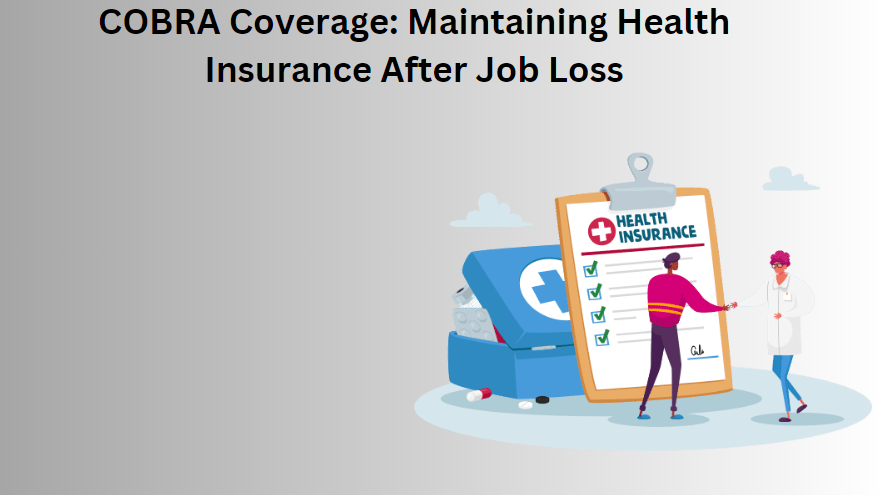Losing a job can be a stressful experience, especially when it comes to maintaining crucial benefits like health insurance. Fortunately, the Consolidated Omnibus Budget Reconciliation Act (COBRA) provides a safety net for individuals who have lost their jobs but still need access to health insurance. In this article, we will explore what COBRA coverage is, how it works, and the steps you can take to ensure you maintain your health insurance after a job loss.Maintaining Health Insurance After Job Loss
Understanding COBRA Coverage:
COBRA is a federal law that allows individuals to continue their employer-sponsored health insurance coverage for a limited period of time after experiencing a qualifying event, such as job loss, reduction in work hours, or divorce. It provides temporary relief, ensuring that you and your family can maintain access to healthcare services during this transition period.
How COBRA Works:
When you lose your job, your employer is required to notify you about the option of COBRA coverage. If you choose to elect COBRA, you will be responsible for paying the entire premium for your health insurance, including the portion previously covered by your employer. However, the advantage is that you can keep the same coverage, including benefits and provider network, that you had while employed.
Eligibility for COBRA:

To be eligible for COBRA coverage, you must have been covered by your employer’s health insurance plan at the time of the qualifying event. You may also be eligible if you were a dependent covered under a family member’s plan. It’s important to note that COBRA coverage is not available for those who were terminated due to gross misconduct.
The Benefits of COBRA Coverage: Why It Matters

COBRA coverage provides a vital safety net for individuals and families during times of transition. By allowing you to maintain your existing health insurance benefits, COBRA coverage ensures continuity of care and protection against unexpected medical expenses. This can be especially crucial if you or a family member have pre-existing medical conditions or ongoing healthcare needs.
Enrolling in COBRA Coverage: How to Get Started
After experiencing a qualifying event, your employer is required to provide you with information about COBRA coverage and the enrollment process. You typically have 60 days to elect COBRA coverage after receiving this notice, so it’s essential to act promptly to avoid a coverage gap. Once you’ve elected COBRA coverage, you’ll be responsible for paying the full cost of the premium, including any administrative fees.
Exploring Alternatives to COBRA Coverage: What Are Your Options?
While COBRA coverage offers a lifeline for many individuals and families, it’s not always the most cost-effective option. Depending on your circumstances, you may be eligible for other forms of coverage, such as coverage through a spouse’s employer-sponsored plan, Medicaid, or the Health Insurance Marketplace. It’s essential to explore all available options to find the best solution for your needs and budget.
Planning for the Future: Moving Forward with Confidence
Navigating the complexities of health insurance can be daunting, especially during times of uncertainty. However, by understanding your rights and options under COBRA coverage, you can take control of your healthcare journey and ensure that you and your loved ones have the coverage you need when you need it most. Whether you choose COBRA coverage or another form of insurance, the most important thing is to take proactive steps to protect your health and well-being. With the right information and resources at your disposal, you can face the future with confidence, knowing that you have a plan in place to safeguard your most valuable asset: your health.
Duration of COBRA Coverage:
Typically, COBRA coverage lasts for up to 18 months, although certain circumstances may allow for an extension. For instance, if you qualify as disabled, you may be eligible for an additional 11 months of coverage, totaling up to 29 months. Furthermore, if a qualified beneficiary experiences a second qualifying event, such as a divorce or death of the covered employee, they may be eligible for an extension as well.
Costs and Considerations:

Maintaining Health Insurance After Job Loss .it’s important to note that it can be costly. Under COBRA, you are responsible for paying the entire premium. Including the portion previously covered by your employer, plus an administrative fee. However, this cost is often more affordable than purchasing an individual health insurance plan. Especially if you have pre-existing conditions or ongoing medical needs.
Exploring Alternative Options:
If the cost of COBRA coverage is not feasible for you, it’s essential to explore alternative options. You may be eligible for government assistance programs like Medicaid. The Children’s Health Insurance Program (CHIP), depending on your income and family size. Additionally, you can consider purchasing an individual health insurance plan through the Health Insurance.. Or exploring short-term health insurance options.
Conclusion:
Experiencing a job loss can be overwhelming, but with COBRA coverage. You can maintain your health insurance and ensure access to necessary healthcare services. Remember to carefully consider the costs and duration of COBRA coverage. Explore alternative options that may be more affordable for you. It’s essential to prioritize your health and well-being during this transition period and make informed decisions about your healthcare coverage.

Recent Comments